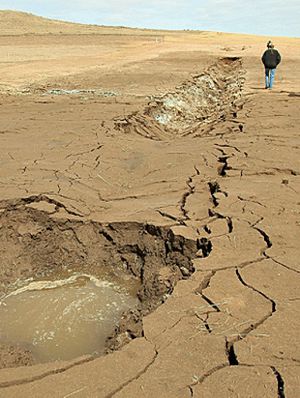Bison Gas Pipeline
| This article is part of the Global Fossil Infrastructure Tracker, a project of Global Energy Monitor and the Center for Media and Democracy. |
| Sub-articles: |
Bison Gas Pipeline is a natural gas pipeline that runs from Wyoming to North Dakota.[1]
Contents
Location
The pipeline runs from Gillette, Wyoming, to Glen Ullin, North Dakota.
Project Details
- Owner: TransCanada
- Current capacity: 407 Million cubic feet per day
- Length: 303 miles / 488 km
- Status: Operating
- Start Year: 2011
Background
TransCanada's Bison Gas Pipeline was built by Michels Pipeline Construction and Price Gregory International, and became operational on Jan. 14, 2011.[2] TransCanada president Russ Girling explained the need for the pipeline this way: “The Rockies was one of the last major North American producing basins that we weren’t connected to."[2]
TransCanada originally bought the pipeline project in 2008 from Northern Border Pipeline Co. as a way of adding new shippers for its planned Pathfinder natural gas pipeline from the U.S. Rockies region.[3]
Expansion Project Details
- Owner: TransCanada
- Proposed capacity: 70 Million cubic feet per day
- Length:
- Status: Cancelled
Expansion Background
Bison currently has 407 million cubic feet per day (MMcf/d) of operational capacity. Its design capacity with compression (approved but not yet constructed) is approximately 477 MMcf/d with potential expandability to approximately 1 billion cubic feet per day. There have been no development updates on the expansion projects since the pipeline's start in 2011 and are presumed to be cancelled.[1]
Accidents
The pipeline exploded in a remote area near Gillette, Wyoming, on July 20, 2011, blowing out a 36-foot section of the pipeline and shaking buildings more than a half-a-mile away.[4] In October 2012, the Canadian Broadcast Company (CBC) published internal TransCanada documents that showed employees were concerned about potential safety issues related to welding and inspection. "We are in trouble on the Bison project," the pipeline's construction manager wrote in Sept. 18, 2010.[5] TransCanada previously claimed that it would be "20 or 30 years" before the pipeline needed any repairs.[6]
Ranchers and others who lived along the route of the pipeline expressed concerns about shoddy construction after soil on top of the pipeline sank in the spring of 2011, as shown in this photograph:

Decline In Demand
The amount of gas flowing through the pipe dropped precipitously after its first year in operation, then dropped to nothing in 2015, according to a June 2016 report by BTU Analytics: "When the pipeline first opened, shippers ramped up volumes to nearly fill the pipeline, but changing natural gas pricing spreads and declines in Powder River volumes left the pipeline empty until the polar vortex of 2013. As storage volumes in the Canadian and Midwest markets have replenished, Bison flows have since returned to zero."[7]

Articles and resources
References
- ↑ 1.0 1.1 Bison Gas Pipeline , TransCanada website, accessed September 2017
- ↑ 2.0 2.1 Bison Pipeline Begins Moving Natural Gas Out Of Rockies, Pipeline & Gas Journal, March 2011, Vol. 238 No. 3
- ↑ TransCanada buys Bison gas pipeline project Reuters, Sep. 3, 2008
- ↑ TransCanada's new Bison gas pipeline blows out in Wyoming, Casper Star-Tribune, July 25, 2011
- ↑ 5.0 5.1 Quality concerns arose before TransCanada pipeline blast CBC, Oct. 24, 2012
- ↑ TransCanada's record presents a strong case for rejecting Keystone XL tar sands pipeline (again), NRDC, Nov. 2, 2012
- ↑ 7.0 7.1 Rockies Natural Gas Pipeline To Be Stranded? BTU Analytics, June 1, 2016.